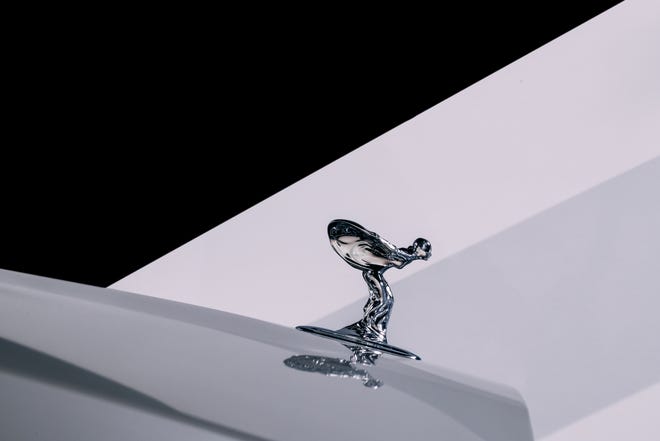One of the auto industry’s most famous and recognizable symbols is getting an update to keep up with the dawning age of electric vehicles.
Rolls-Royce Motors’ iconic Spirit of Ecstasy hood ornament — the Flying Lady to her friends — underwent 830 hours of modeling and wind-tunnel testing to become sleeker and more aerodynamic as the revered luxury brand prepares for an all-electric future.
The original Spirit of Ecstasy, a winged female figure that borrowed from classical Greek sculpture and art nouveau and foreshadowed elements of art deco, was registered as Rolls-Royce’s intellectual property in England on Feb. 6, 1911.

The new hood ornament will debut on Rolls’ first electric car, the Spectre luxury sedan, which is expected to go on sale in the fourth quarter of 2023.
The new hood ornament has a lower stance, Rolls says, is more dynamic and in line with sketches by early 20th century illustrator and sculptor Charles Sykes, who created the original Spirit of Ecstasy.
Updating an icon
The new mascot is 3.4 inches tall, compared with 4 for the current version. The robes — often mistaken for wings, hence the Flying Lady nickname — flowing behind the figure were reshaped to be more aerodynamic.

The figurine’s stance is more realistic — body leaning forward, rear foot braced, the other leg forward. The previous ornament’s feet were together, its legs straight as it leaned forward at the waist.
The new figurine’s hair and facial features are more realistic. Rolls designers also consulted historical experts about her hair, clothes, posture and expression. The new shape was sculpted by a Rolls computer modeler.
In addition to being more natural, Rolls says the new sculpture contributes to 0.26 coefficient of drag for early Spectre prototypes, making it the most aerodynamic model in Rolls’ history.
The Spirit of Ecstasy has changed before. Over its 111-year history, the figurine has been rendered in various materials and sizes. An optional version that had the figure kneeling was available in 1939-54
More: As it embarks on 2nd century, Lincoln builds on storied legacy
A celebrated sculpture and a secret love
Eleanor Velasco Thornton, an actress and dancer who also worked at the British Automobile Club, was Sykes’ model for an early sculpture called “The Whisper” that would adorn a number of Rolls-Royce vehicles owned by John Walter Edward Douglas-Scott-Montagu, publisher of the Car Illustrated magazine. The actress and the nobleman had a long relationship, which Montagu never publicly acknowledged because they were from different classes. Thornton died when the ocean liner they were traveling on was torpedoed in 1915.
There may have been multiple inspirations for the Spirit of Ecstasy, however. Some sources suggest its face was modeled after that of Sykes’ mother.

Thornton was also the model for other Sykes sculptures.
The mascot became standard on all Rolls-Royce cars because engineer and company co-founder Henry Royce was sick of customers commissioning their own hood ornaments, including devils, black cats and a caricature of a policeman.
The statue was originally called the Spirit of Speed. However, an early letter from the company said Sykes had sought to capture “the Spirit of Ecstasy, who has selected road travel as her supreme delight and alighted on the prow of a Rolls-Royce car to revel in the freshness of the air, and the musical sound of her fluttering draperies.”
An electric car 123 years in the making
That original 1911 statue was nearly 6 inches tall. The distance from its nose to the fluttering robes was 5 inches.
The Spirit of Ecstasy was named the world’s best car mascot at a 1920 contest in Paris.
The Spirit of Ecstasy didn’t become standard equipment on Rolls-Royces until 1939. Before that, about 40% of customers paid for it.
Today’s hood ornaments are stainless steel.

Company founder Charles Rolls admired early electric cars. “The electric car is perfectly noiseless and clean,” he said after a brief ride in one in 1900. “There is no smell or vibration, and they should become very useful when fixed charging stations can be arranged. But for now, I do not anticipate that they will be very serviceable — at least for many years to come.”
The company began testing ideas for electric cars in this century. The 2011 102EX was a drivable electric version of its Phantom production car. The 2016 103EX tested ideas for a future electric production model.
